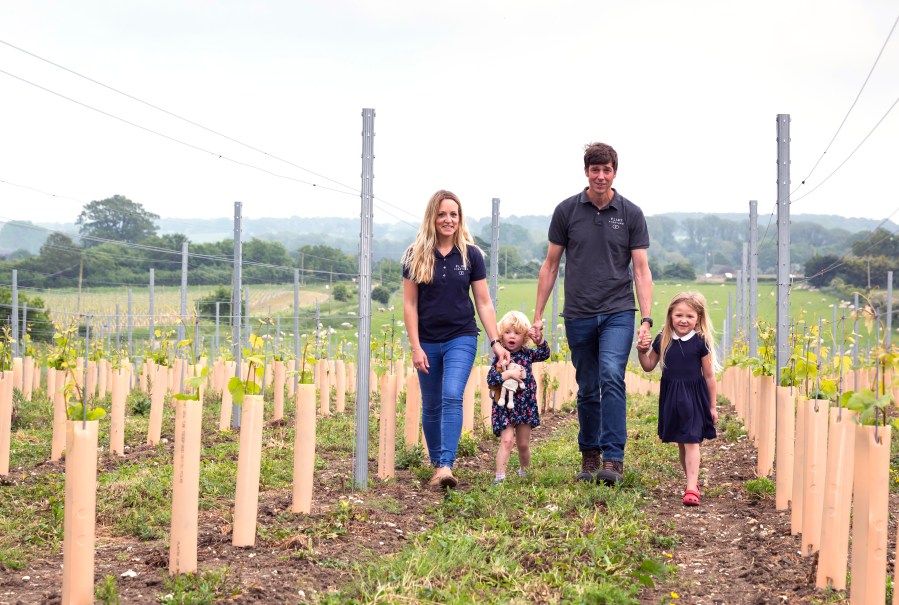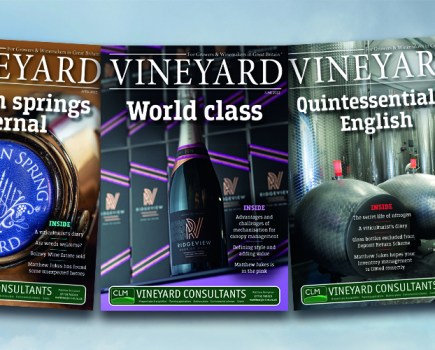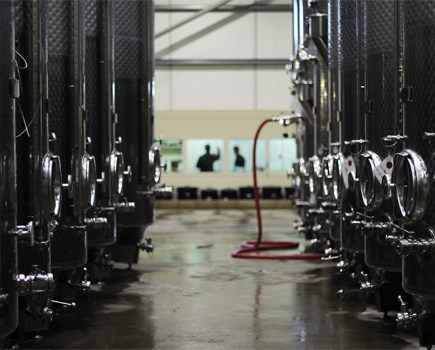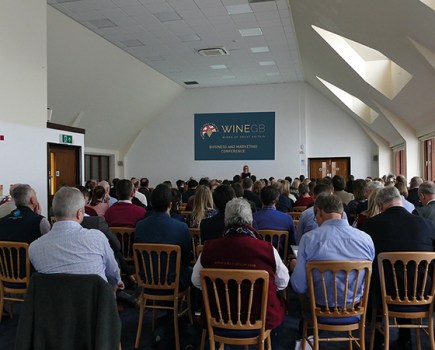Just outside the village of Earsham, nestled in Norfolk’s Waveney Valley countryside, you will find a collection of beautifully converted agricultural buildings. Having once been used as a farm office and grain store for an arable enterprise, the site is now home to one of the country’s most innovative and exciting new English wine producers, Flint Vineyard.
Husband and wife team, Ben and Hannah Witchell started their journey into the English wine industry in 2007 after a shared passion for the subject took them on a one-year travelling experience around the wine making regions of the Southern Hemisphere.
“From Chile and Argentina, to South Africa, Australia and New Zealand, we visited as many regions as we could in that time,” said Hannah Witchell. “We spent a month working as volunteers at a vineyard in Mendoza and that is when our knowledge and our interest in wine reached a new level.”
Dissatisfied with the prospect of resuming his career in IT, on returning to the UK Ben took it upon himself to study the Wine and Spirit Education Trust (WSET) Levels 1 to 3, before reaching out to almost every vineyard in England to try and find a job.
“I didn’t mind working for free as long as they could turn me into a winemaker,” said Ben Witchell. “Quite a few people responded saying that if I really wanted to take it seriously I should go to Plumpton College and get a qualification behind me.”
Determined to turn his passion into a career Ben and Hannah moved to East Sussex and although Ben initially embarked on the two-year diploma, his thirst for knowledge led to him stay on for the full three-year BSc. Ben came out of the process with a first-class degree, was named top winemaking student and also received an award for the best dissertation.
“The fantastic thing about Plumpton is that you are immersed and taken over by the science of grape growing and winemaking,” said Ben. “Tony Milanowski is a really inspirational lecturer and without a doubt the experience transformed my knowledge and changed my perspective of what goes into winemaking. I couldn’t be doing what I am doing now if I hadn’t been to Plumpton; it is defiantly a fast track to a career path.”
To further his academic understanding, during his time at Plumpton Ben undertook work placements at Davenport Vineyard, Kent, and Fox and Fox, Sussex, and worked for a vintage in Cephalonia, Greece and Napa Valley, California.
Upon graduating, Ben took his first job as assistant winemaker in Morgon, Beaujolais, France. It was here that he harnessed the balance between science and tradition, learning to “throw out the rule book” and embrace the region’s traditional techniques. It was from this marriage of science and tradition that the Flint Vineyard venn logo was born, with each circle designed to represent the two sides of Ben’s winemaking.
Establishing the vineyard
While working in France Ben and Hannah came to realise that they wanted to start their own estate and despite looking at several vineyard properties across the Channel they decided to return to the UK.
“We started looking at East Anglia because one of the projects Ben had worked on at Plumpton involved looking at Met Office data and mapping it over the UK,” said Hannah. “Through analysing sunshine hours, rainfall, frost and other factors Ben had pinpointed the region as the most suitable for growing vines. It really is the sunniest and driest area; forecasted rain often never arrives.”
As Hannah’s parents had retired to the area, the couple were familiar with small pockets of the region and in their search for suitable land they came into contact with local arable farmer Adrian Hipwell.
“Adrian said that he had some land on a south-east facing slope with free-draining soil full of sand, gravel and flint,” said Hannah. “We came to see the site and knew it had a lot of potential so sent the soil off to be analysed. When we came to meet Adrian we also saw the number of agricultural buildings which could be utilised and the farmhouse which we now live in. It was a great opportunity for us.”
Having farmed the land for over 30 years under a life tenancy agreement, Adrian was unable to sell the site and could not sub-let it either, so Ben and Hannah decided to go into partnership. As 50/50 partners Adrian has also invested half of the capital for the project.
In 2015 Ben and Hannah started preparing the site and alongside the traditional check list of jobs, Ben worked with Climate Wine Consulting to pinpoint the low points in the vineyard and to predict where the frost pockets and cold air drainage may be located.
“Before we planted we did a lot of work with Alistair Nesbit,” said Ben. “He has access to lots of accurate, historic weather data, as well as topographical scanned imagery which gives very accurate contour lines and we overlaid a lot of this imagery on to our vineyards. We also have a weather station and temperature probes dotted around the vineyard to continue surveying the wind and frost patterns.”
One year later the first vineyard was planted – just under three hectares of Bacchus, Pinot noir, Pinot noir précoce and Pinot blanc. In 2017, a smaller plot of Bacchus was added in front of the tasting room and this year 11,000 vines went in, with Pinot gris added alongside the original line up.
“In total the estate spans 170 acres but there is only another hectare of suitable vineyard land here,” said Ben. “If we were looking to expand further there is always the option to lease or buy elsewhere as there are some really good plots of land around. The glacial area has really interesting deposits in the soil.”
Supervised control
Following the French philosophy of lutte raisonnée, which translates to ‘supervised control’ Ben takes a sensible approach to vineyard management considering both traditional and sustainable practises.
“Sustainability is an overused word and not necessarily always understood,” said Ben. “In the vineyard we are moving towards under vine cultivation and have just invested in a Boisselet from David Sayell at Vitifruit Equipment to clear the weeds in between and underneath the vines without the need for herbicides because I want to look after the soil and reduce the chemical input.”
Ben only sprays the vines when it is absolutely necessary and chemical usage is also kept to an absolute minimum with help from Ben’s Martignani electrostatic sprayer. The technology, which was featured in Vineyard’s May edition, electrically charges optimally sized droplets allowing for good coverage, reduced water rates and lower chemical rates.
“These machines are widely used throughout Prosecco and growers there are finding that they can reduce their chemical usage by around 30% to 40%,” said Ben. “We have dropped the water rates to around 200 litres per hectare and because we are putting on a slightly more concentrated product as a fine mist and getting a good coverage we can use lower chemical rates.”
Following a nutrient based approach to spraying, Ben also applies a number of foliar feeds to keep the plants strong and healthy through their various stages of growth. Soil was analysed before planting and yearly leaf analysis allows Ben to check how the vines are doing.
“I think we are slightly deficient in magnesium, so we need to top that up,” said Ben. “We use foliar feeds rather than correcting the soil because that is the most efficient way to give the plant what it needs at particular stages. If the vines have what they need they should be more resilient to disease and so we can spray lower levels of fungicides.”
Looking out for the biodiversity, the site is surrounded by natural vegetation, hedgerows and wildflower borders. There are also numerous naturally occurring wildflowers, such as poppies, within the rows and grass also helps with soil structure, prevents erosion problems and generally maintains a healthy ecosystem.
In dealing with the problem of medium sized deer, Ben has opted for a more humane approach with electric fencing used to hopefully train the deer to stay away instead of constructing large fencing which the pests can often get tangled in.
Top end equipment
The year spent preparing the land for planting gave Ben and Hannah the time to apply for funding and the couple successfully received a Rural Development Programme for England LEADER grant, based on job creation and tourism prospects, as well as a UK government grant for research and development.
As Ben knew his calling was in the winery, this stream of revenue enabled them to develop a bespoke winery and laboratory with top end equipment in the farm’s old grain store in year one.
“If we were going to put the winery in it was so important that we did it properly,” said Hannah. “Ben has high standards and we wanted to put in a really high spec facility. Ben and Adrian installed all the tanks and the glycol temperature system themselves. Adrian’s practical skills have been amazing and he has a lot of knowledge which we have been able to tap into.”
The funding and development of the research programme has allowed Ben to invest in an inert gas press. There are only a handful of these currently in the UK and while reductive inert pressing with nitrogen can preserve more aromatics, as exposure to oxygen can degrade the volatile aroma compounds, it is not suitable for all styles of wine.
“Preventing oxidation from happening can leave polyphenols in the wine which can potentially lead to bitterness and astringency,” said Ben. “Also, wine can become more susceptible to oxidisation as you are not removing those compounds at the start of the process. It is not really suitable for traditional method sparkling wines either as if you have a very aromatic base wine it can interfere with the autolytic flavours from the lees aging.”
The inert press at Flint Vineyard is also capable of pressing conventionally and Ben sees it as another tool in the winery, providing him with as many winemaking options as possible. The Bacchus, for instance, is pressed both oxidatively and reductively providing two very different juices, with the reductive juice giving a really green, fresh juice.
The use of nitrogen in the winery has also been extended to the tanks. Seeing variable volume tanks as unsanitary, Ben has designed his own positive pressure system which replaces the oxygen in the headspace of fixed capacity tanks with nitrogen.
“It is a really straight forward closed loop system,” said Ben. “As the wine changes temperature and breathes, rather than sucking in oxygen through the vent it will take in nitrogen. If it increases in volume, it just pushes nitrogen back out to the atmosphere, which means that you don’t need to take a lid off and you are not introducing any bacteria or dirt into the wine. It keeps our system a bit cleaner.”
The winery also benefits from a sorting table which helps Ben to hone down the quality of the fruit and effectively removes material other than grape (MOG).
“Even if you have your own gang of pickers and you tell them to sort in the vineyard, they are picking for hours and can lose concentration,” said Ben. “We are sorting for Powdery mildew, rot, grape ripeness and then leaves and insects. Sometimes fruit comes in perfectly, but I always want to have the option to sort the fruit.”
Bacchus research
Having received a grant from the Eastern Agri-Tech Growth Initiative, a programme designed for research and development in the food and beverage industry, Ben is also working on a special project looking into the characteristics of Bacchus.
“It is the first research of its kind in England,” said Ben. “We have collaborated with Camden BRI who analysed 19 different Bacchus wines from 2015 using Gas Chromatography/Mass Spectroscopy (GC/MS). We have also been working with Plumpton College, who sent us wine samples to work on and one of their students also came to work with us on a placement last year.”
The first stage of results, looking at whether there is any typicity in Bacchus and the variety’s aroma compounds, has been widely published and is available on request from Ben.
The next stage of the project aims to investigate what happens to the aroma compounds when they undergo particular techniques. Ben will focus on different methods of processing from levels of oxidation during pressing, to different types of yeast strain and different fermentation temperatures.
“After attending Plumpton, I became really interested in oenology and the science of wine,” said Ben. “The science has driven our brand, our vision and the company philosophy, so doing the research fitted in perfectly with that. It just started off as an interest and led to a grant. It was indispensable.”
Innovative winemaking
Waiting for their vines to flourish, for the past two years Ben and Hannah have been sourcing fruit from other growers in East Anglia including Humbleyard in Norfolk, Martin’s Lane, and Great Whitman’s Farm in Essex, to produce a range of still and sparkling wines.
“At the moment we work very closely with three other vineyards,” said Ben. “We agree with them what sort of yields we are going to take and I will do all the harvest monitoring, testing and analysing for sugars and acids to decide when to pick.”
Drawing upon his first winemaking job in Beaujolais, Ben is now developing his own approach to English red wine and is a big fan of Pinot noir précoce, considering the variety as similar to Gamay in character.
“I used all of the experience from Beaujolais to make our red wine,” said Ben. “My approach to making a Pinot noir in England is not to worry about trying to extract too much colour and not trying to make a big red wine. I think an English red has to be aromatic, perfumed and soft. I had the confidence to know how it would work and to make wine as I wanted to.”
To manage the quality of the juice, the first 400 to 500 litres of free run juice are fermented separately and for the Flint Bacchus, six separate tanks of Bacchus are made with different techniques to produce completely different wines which are then blended to produce a premium end-product.
“As well as separating the different press factions, we also pick the Bacchus at different ripeness levels,” said Ben. “This year we had some Bacchus at 70°Oe and the majority at about 80°Oe. The riper tends to the tropical and the less ripe tends towards the greener, herbaceous flavours. We also treat the fruit differently, some of it we whole bunch press, some of it we crush and de-stem, some of it we press under nitrogen and some we give a slight exposure of oxygen. Then there are different levels of juice clarity, different temperatures of fermentation and different yeast strains that we use.”
Alongside the still wines, Ben is also working on a premium traditional method sparkling, keeping back free run reserve wines each year. Currently there are four barrels of blanc de noir in the cellar which Ben hopes to blend in five or six years to produce a non-vintage cuvée which will then have five years’ bottle aging.
While all of the premium still and traditional method sparkling wines are produced with the high-quality free run juices, keen to use the grapes to their full potential and taking an innovative approach to the range on offer, Flint Vineyard will shortly be releasing a Charmat method sparkling wine.
“We are planning to release our Charmat method later in June,” said Ben. “For me as a winemaker I am doing it based on integrity. It is not about releasing a cheap Charmat into the market. I think that is a really good way of utilising certain press factions that I don’t want to put into my premium still or bottle fermented wines.”
While English sparkling wine has been focused on the bottle fermented method, Ben also sees the tank fermented route as an opportunity to use varieties which are not suited to the traditional method.
“We have some really aromatic varieties like Solaris and Bacchus which don’t lend themselves to making a traditional method sparkling wine,” said Ben. “But why shouldn’t you use them for a more approachable sparkling wine which can be enjoyed younger?”
Just 4,000 bottles of the sparkling rosé, which will retail around the £20 mark, are set to be produced from a considered blend of Bacchus, Rondo, Reichensteiner and Solaris. The Solaris has been whole bunch pressed, barrel fermented and has undergone extended lees aging in specially adapted barrels which sit on rollers allowing Ben to lees stir without introducing oxygen.
“It is not a basic wine,” said Ben. “We wanted to give some lees flavours which you don’t normally get from the Charmat method. We are making a different product and I think it is a positive thing for England to have.”
While the Charmat is likely to cause a mixed reaction from the rest of the English and Welsh wine community, Ben is very clear that this Charmat is not set to challenge traditional method sparkling wines and he doesn’t believe that his small volume release will have an impact on the wider industry.
“We are not trying to replace English sparkling wine and are making it very clear through the way we are bottling it and presenting it that it is not a quality English sparkling wine in the traditional method,” said Ben. “We are calling the product Charmat and making it clear on the label. We wouldn’t want anyone to think we were trying to pass off a Charmat as an English sparkling wine. I think there will be a spilt in opinion with those who feel that it is an innovative move and those who are very proud of the traditional method.”
A sense of community
The opportunity for Ben to get creative in the winery and experiment with different techniques has also been facilitated by the exclusive VENN club which has been established for Flint Vineyard’s followers and provides members with small batch, limited release wines.
“For the Venn club wines we can trial all sorts,” said Ben. “This year, for instance, we made a Sauvignon blanc Bacchus blend. With the Sauvignon blanc we crushed de-stemmed it and held it in the press under nitrogen for 24 hours to try and get the flavour from the skins, a technique they use in New Zealand. That was quite unusual. We produce just 600 bottles and if everyone enjoys it then we can look to do it on a more commercial scale next year.”
Having started selling VENN club membership in December 2016, Ben and Hannah created the scheme so that people could be a part of their journey, helping to build brand loyalty and developing a sense of community around the vineyard.
“The VENN club is one of the best things we have done since we started the vineyard,” said Hannah. “We came up with the concept long before we had made any wine and we felt that if people could get involved with us from the start and could feel part of the journey that would be a huge benefit.”
As well as receiving exclusive wines, VENN club members are also entitled to a 10% discount on wines, to complimentary tours for up to six people, which further helps drive traffic to the vineyard and the chance to be involved at key times of the year.
“There is a core of members who come and help us in the winery during harvest, during planting, with bottling day and they feel a part of what we are doing,” said Hannah.
Hannah also organises the tours at Flint Vineyard, which are given by Ben every Saturday, and collaboration with Adrian’s son who has a micro-brewery on the site has also helped to develop a regular, well-attended Friday night festival.
“We have started doing events once a month on a Friday night,” said Hannah. “We have street food vans, live music and the Ampersand brewery and our tasting room are open for beer and wine sales. There are no entry fees; it is just about having local wine and local beer in a nice atmosphere.”
As the whole area is becoming a destination for people who enjoy artisan producers, Hannah has also created a simple yet effective 15-mile lunch, with charcuterie, cheese and breads sourced from within 15-miles of the vineyard.
“Our idea was to do one thing and to do it really well,” said Hannah. “It is going down really well because it pairs well with the wines, it is really local, you can almost see the cheese producer across the valley, and it is simple.”




